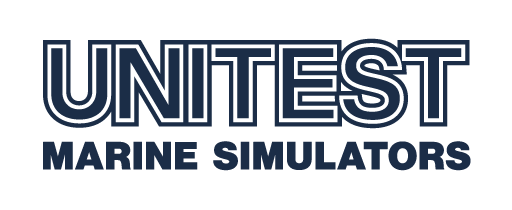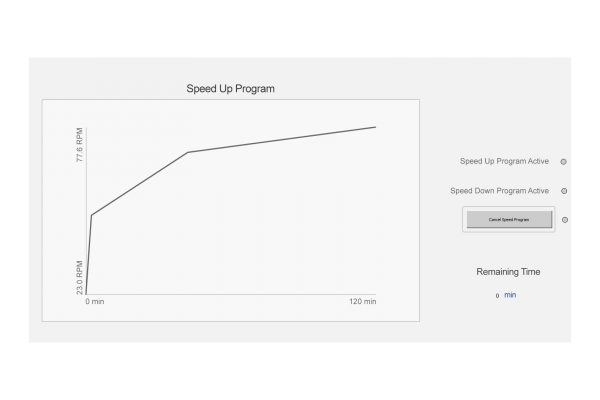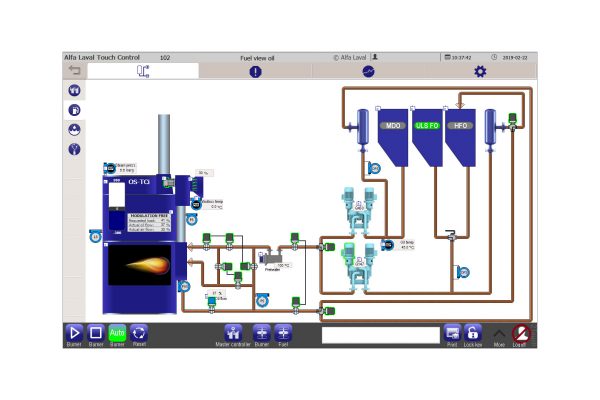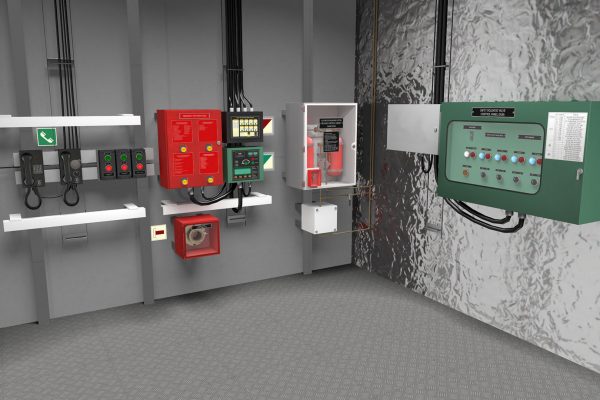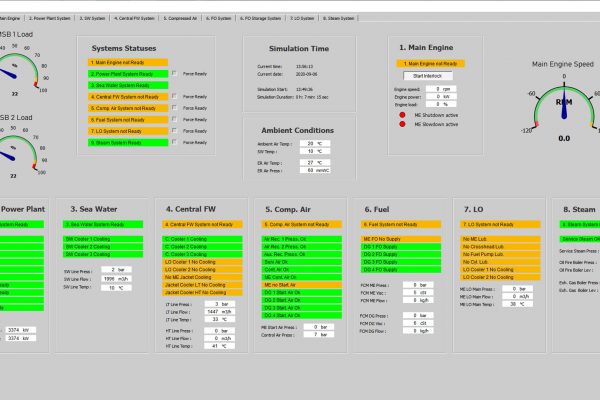Low Speed Engine Room Simulator
Unitest X92 engine room simulator was developed in close co-operation with many manufacturers of the ship machinery, such as Winterthur Gas & Diesel (Main Engine), Alfa Laval (Fuel Conditioning Module, LO & FO Purifiers, Fresh Water Generator, Ballast Water Treatment System) and Aalborg (Oil-Fired & Exhaust Steam Boiler).
The simulation and scenario editor mode for training emergency operating procedures when faults occur on low speed main engine, supporting systems and auxiliary machineries.
The main purpose of the simulator is the practical preparation of the trainee for engine room operation, and more particularly:
- familiarization with electronically-controlled common-rail technology and flexibility of the fuel injection and exhaust valve operations;
- familiarization with the engine room installation (electric power plant system, compressed air system, fresh and sea water cooling system, lubricating and fuel oil system);
- acknowledgment with diesel generators and auxiliary equipment starting procedure;
- propulsion system manoeuvring;
- power management system operation PMS.
Engine model and control systems
The X92 simulator offers a detailed simulation of the behaviour of the modelled engine with regard to the operational aspects, its functionality and performance. The simulator includes the following systems:
- Power Management System which contains all standard functions, such as load dependant start/stop, load sharing, synchronising, and load shedding.
- The Alarm and Monitoring System allows the operator to control all propulsion system equipment parameters.
The optimal approach ensuring the realism of engine room operation training is achieved by integrating a very realistic mathematical model and high-fidelity 3D presentation. The X92 simulator offers highly realistic graphics of engine details that are directly connected to the real control diagrams. All solutions in the simulator are based on the real ones and have been thoroughly verified by the engine’s manufacturers.
Intelligent Combustion Monitoring
Intelligent Combustion Monitoring system for continuous pressure measurement and analysis with primary features includes: graphic presentation of PT, PV and Balance Diagrams, together with Mean Indicated Pressure and Maximum Pressure deviation limits. Calculated values of Effective Power, Mean Indicated Pressure pi, Compression pressure pcomp, Maximum pressure pmax and Scavenge pressure pscav include values for fuel injection and exhaust valve adjustment.
Special attention has been paid to the modelling of the main engine because Unitest simulators are used as the main training environment on specialized engine courses. Because of that, the X92 simulator uses a detailed thermodynamic model to calculate the combustion process in the real time. It is also possible to observe the influence of many engine adjustment parameters and offsets (exhaust valve, injection process) on the calculated indicator curves.
The X92 simulator is unique.
The X92 also has several unique features, such as:
- The graphic visualization of the dynamic engine working point within the engine limits curves.
- The compressor map operational curve with a surging margin. In combination with the possibility of simulating turbocharging system faults, it is an extremely valuable teaching tool.
- The possibility to set the engine control parameters in the same way as in the real engine via the FlexView interface, which is a copy of the original WinGD engine control software. This includes also the simulated Intelligent Combustion Control System with auto and manual control.
Engine Room overview
All operations in X92 simulator can be done in specific system installation and compartments. Each system is presented as a real vessel’s schematic drawings or compartment with the ability to control on the screen. The most important components of the scheme can be zoomed and directed to the proper location in the engine room to operate.
The simulator is divided into the following modules:
- Bridge
- Diesel Generator
- Emergency Generator
- Main Engine
- Compressed Air System
- Cooling System
- Lubricating System
- Fuel System
- Steam System
- Ballast System
- Steering Gear System
- Bilge System
- Steering Gear
- CO2 Fire Extinguishing System
- FW & Sanitary Water System
- Bilge System
- Stern Tube Seal
- Sewage Treatment Plant
- Refrigerating Plant
- AC Plant
- Incinerator
Overview, checklists, assessment tests
The program interface has been designed in such a way as to enable efficient and effective navigation around the engine room. At the same time, navigation provides the simulator exercises realism very close to reality.
The simulator uses an original navigation technique based on zooms in the 3D environment and dedicated navigation maps.
The overview windows enable a quick overview of the situation in the engine room. The green colour means: ready for the operation, while orange: not ready for the operation. The particular statuses are displayed for the whole subsystems (SW System, FW System etc) and the individual equipment (coolers, generators). Detailed information on the statuses in each system is available after selecting the appropriate tab. In addition, the detailed screens display statuses of manual valves, pump statuses and main parameters are also available.
The main purpose of checklist introduction is to teach the user the proper engine room operation. This will be especially important when X92 is used in the stand-alone mode, i.e. without the instructor’s support. The checklists combined with an assessment should create new standards for ship engineers training and competency verification.
The simulator includes a set of automatic tests that are used to assess the competences of students.
X92 simulator main features:
-
- Highly realistic simulator for engine room training. All engines and propulsion plant behaviours are faithfully reproduced. In order to create the impression of working in the real environment, it provides 3D sound which can be heard in 2, 4 or more speakers.
-
- Familiarization with electronically controlled common rail technology and flexibility of the fuel injection and exhaust valve operations which allow users to improve the combustion process in various revolution ranges.
-
- The thermodynamic model offers visualisation of cylinder pressures depending on operating conditions.
-
- The mathematical model simulates ship’s main propulsion plant, low speed, 10 cylinder, 2-stroke, turbocharged and reversible diesel engine.
-
- All vital auxiliary systems are implemented.
-
- The user’s interface includes virtual controls and alarms that create a very realistic environment. The 3D virtual reality with active valves, tank level indicators and selected digital gauges enables comfortable engine room operation and monitoring. Zoom function allows navigation in 3D environment and easy access to details.
-
- Multichannel digitized sound provides a very realistic engine room feel. The sound effects include engine sound correlated with engine speed.
-
- Emergency procedure training includes fire simulations.
-
- Operations related to drivers subsystems include valves operations and all auxiliary equipment (pumps, coolers, purifiers, etc.).
-
- Drives operations from the following stations:
-
- – Control from the bridge: navigation bridge console panels allow to operate the propulsion plant;
-
- – Engine Control Room: water mist system, control of propulsion plant;
-
- – Local control of engine room equipment: Main Engine and Diesel Generator Local Operation Panels,
-
- – Starting and controlling of air compressors, fuel filters, electric motors, fan starters, boiler and more.
-
- Drives operations from the following stations:
-
- Learning engine room typical operating routines.
-
- Engine room operation training. The user will have the possibility to accomplish any operational task starting from different set-ups, both pre-prepared and saved by the user.
-
- Corrective action learning when faults occur. Different faults can be simulated and mixed in the run-time or loaded from disk.
Main Engine Data
Type: Winterthur Gas & Diesel 10X92
Cylinder bore: 920 mm
Piston stroke: 3468 mm
Stroke/ bore: 3.77
No. of cylinder: 10
No. of air coolers: 2
No. of Turbochargers: 2
Engine Speed: 77.6 RPM
Rated power: 50190 kW
Ship Data
Type: container ship
Engine Room Type: low speed
Length: 366 m
Width: 49 m
Max. Speed: 22 kn
Dead Weight: 148992 t
Gross Tonnage: 140872 t
TEU:: 14400
To meet the requirements:
Engine Room Simulator has been developed to comply with STCW Code:
- Section A-1/12 and Section B-1/12
- ISM Code: Section 6 and Section 8
